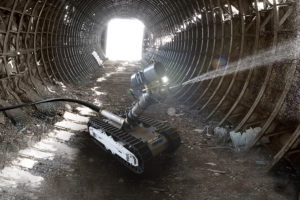According to recent reports,* just one forced outage can cost a power plant up to $1M dollars in lost generation and increased maintenance costs. So, it’s not surprising that many plant managers view downtime as the single most influential factor affecting their bottom line. Though despite this realization, time and time again we find that measures taken to avoid downtime, such as increased cycling or lack of preventive maintenance planning, can actually cause unnecessary shutdowns, creating a costly recurring challenge for industry leaders to overcome.
By investing in measures like safety training, automation and preventive maintenance planning, plant managers can reduce both the frequency and the duration of unplanned outages. This will in turn increase efficiency at power plants.
Automated tooling offered by MPW
MPW offers automated tube lancing with its SAL-1 and MAL-3 machines. Both systems are optimal for confined spaces and have adjustable speed cleanings. In contrast with SAL-1, a handheld device, MAL-3 utilizes a remote-control system that fully removes an operator from hazardous areas.
The RB X-40 robotic blaster also provides companies with incalculable value in both safety and efficiency. Fly ash buildup in the duct work at one particular power plant elicited much concern from plant operators. The ash, which in some areas piled up to eight feet deep, often reached temperatures of 800 degrees. RB X-40 eliminated the need for a technician to enter confined spaces and clean fly ash. The robot’s ability to cut down on plant downtime greatly exceeded the customer’s expectations, and the plant could run its boilers even longer as a result of RB X-40’s quality cleaning job.
Six steps to increasing efficiency at your power plant
1. Safety
While not the most obvious cause of downtime, accidents happen frequently at power plants. Instituting proper safety protocol like wearing personal protective equipment, having the appropriate signage and minimizing clutter in critical areas can prevent accidents from happening. At worksites, MPW professionals hold regular safety meetings, during which they meet with other plant employees to ensure all safety protocols are being followed.
2. Automated tooling
Finding unique ways to replace manual labor with automated equipment can have numerous benefits when it comes to reducing downtime. While keeping employees out of harm’s way is a common benefit of using such tools, automation also increases consistency and can improve the quality of work performed. The success of MPW’s automated tooling on the job site speaks for itself.
3. Job walks
Though often overlooked or eliminated, job walks are a quick and easy way to spot potential hazards and bad actors. MPW allocates three to four specialized personnel to walk the job site before a customer engagement begins. Small, regimented programs like these give employees a better sense of the total picture, allowing for a more comprehensive repair. Job walks also present great opportunities for further training of staff.
4. Emergency support
Addressing emergencies in a timely manner can vastly limit the amount of unnecessary downtime for plants. That’s why having a support staff on call 24/7 is crucial to running an operation. Regardless of when an emergency occurs, MPW’s emergency support dispatchers are constantly on call and able to get the right personnel to a site at any given time. From hydro excavation and vacuuming, to power washing, the team at MPW can provide the services necessary to support an operation during an emergency.
5. Staff training
No plant can efficiently operate without a well-trained staff. And without a keen awareness of safety, staff members can fall victim to unnecessary accidents. Each new hire at MPW Industrial Services goes through 10 hours of OSHA training before setting foot on the job site. MPW’s Training & Development Department also ensures that employees receive 30 hours of hands-on and classroom training, where they learn how to operate a wide range of industrial equipment, in addition to maneuvers like confined space rescue. Staff also undergo a leadership development section during their training period, which helps team members build trust in each other, while facilitating a greater sense of responsibility and teamwork.
6. Preventive maintenance
Without adequate staff training, implementing proper preventive maintenance measures becomes impossible. Quality staff training can make the difference between spotting a small issue that prevents an expensive repair and dealing with added downtime. Addressing potential causes of downtime with a preventive maintenance plan can save power plants lots of money in the long run. Staff can lay the groundwork for an effective plan by gathering data on the operation’s performance and assessing which problems require outside staff to fix, and which ones can be handled internally. Once plant personnel gather data on the operation and its pain points, they can devise a repair schedule to deal with problems as they arise.
